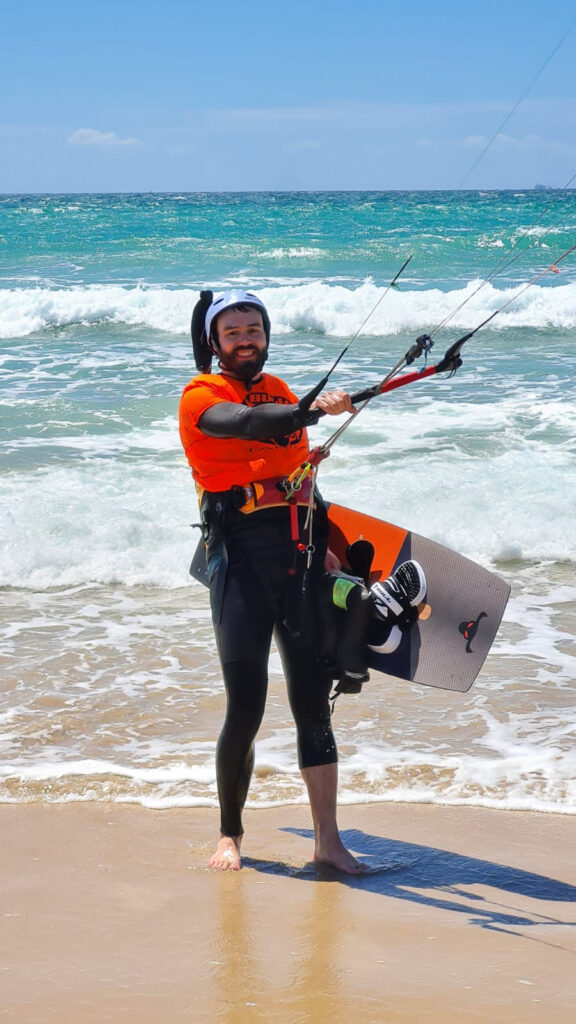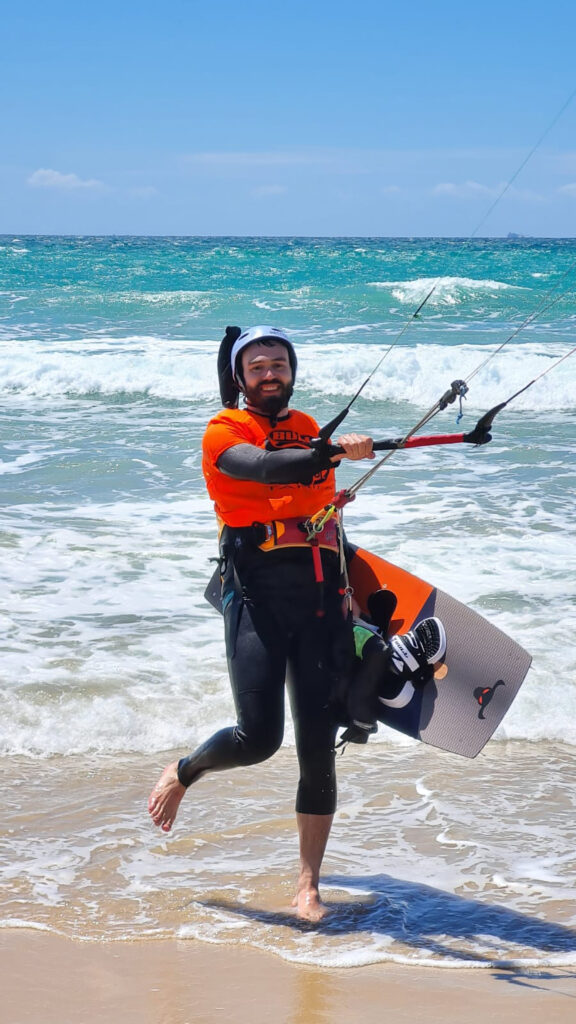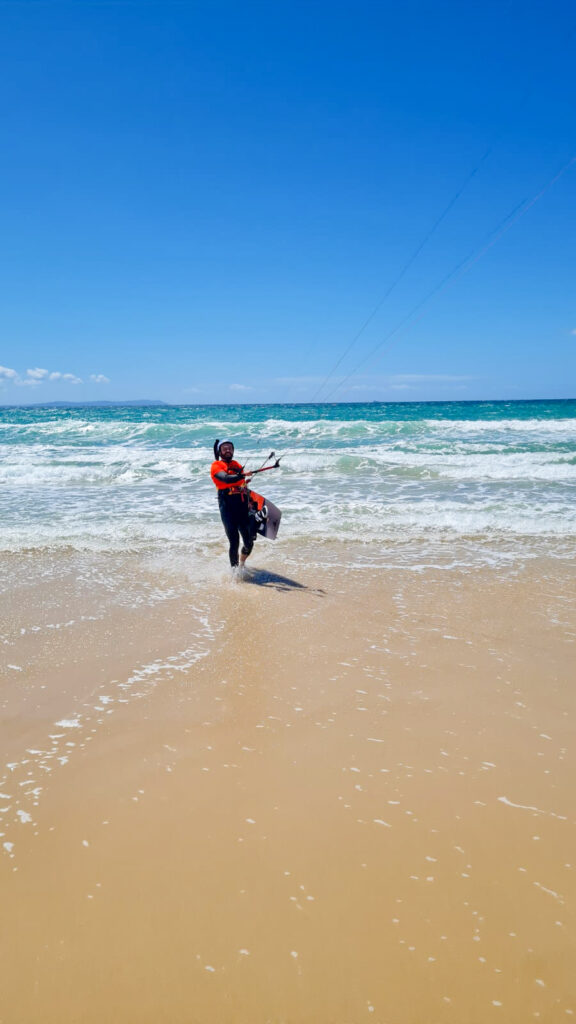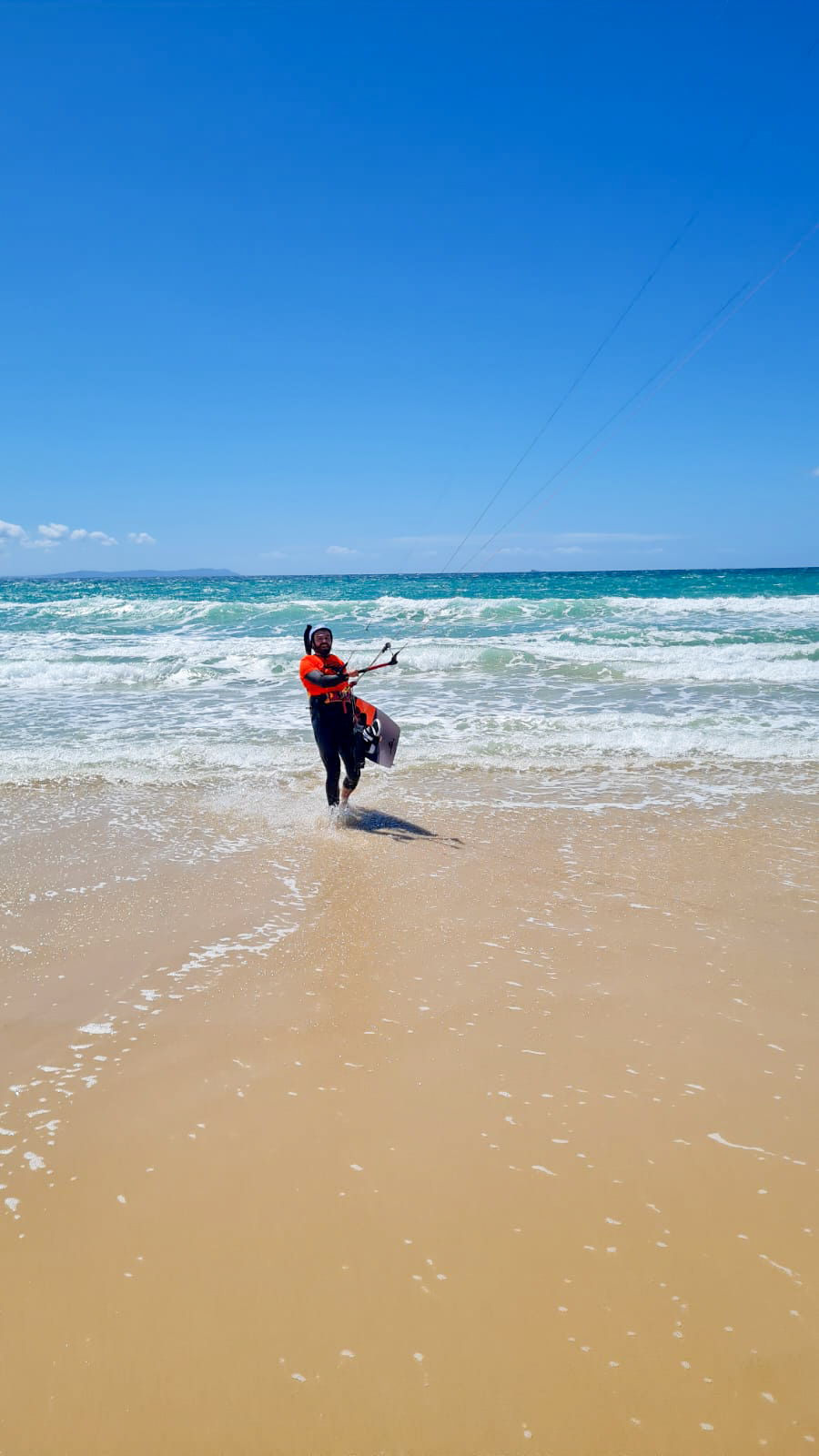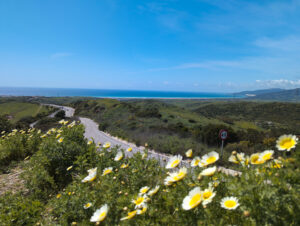Tarifa. The name itself carries weight in the world of wind sports, derived, legend holds, from Tarif ibn Malik, the Berber chief who led the first Muslim reconnaissance raid on southern Iberia in 710 AD. Its strategic position guarding the Strait of Gibraltar has shaped its history for centuries, making it a vital port and fortress under Moorish rule and beyond. Today, that same strategic position, funneling wind between continents, makes it Europe’s undisputed kitesurfing capital – a place that conjures images of vibrant kites against piercing blue skies, the constant rush of wind, and the intoxicating promise of freedom on the water. For three weeks in April, this legendary town was my basecamp. My dual mission: make significant progress on my Master’s thesis during downtime, and immerse myself in learning to kitesurf whenever the infamous Tarifa wind played ball.
But Tarifa, steeped in history and wind-fueled adrenaline, reveals a more complex reality for the aspiring kitesurfer. The glossy photos often omit the brutal strength of the Levante, the frustrating inconsistency, the choppy waters, and the sheer perseverance required. It’s an undeniably electric place, buzzing with a unique energy, but it demands respect, patience, and frankly, might not be the smooth-sailing beginner’s paradise often portrayed.
This post strips away the veneer and dives deep into the gritty reality of my journey learning to kitesurf in Tarifa. This isn’t just a highlight reel; it’s the full, unvarnished breakdown – the detailed day-by-day lesson log, the exact itemized costs, the breakthroughs and the exhausting setbacks, honest feedback on my chosen school (Bull Kiteschool), and a critical analysis of whether Tarifa is the optimal starting point versus other global kite hotspots. If you’re dreaming of learning to kite, especially solo in Tarifa, this detailed account aims to give you the information I wish I’d had.
What’s in this detailed guide:
- Tarifa’s Legacy & Challenge: A Glimpse into History & Why the Wind Capital Isn’t Always Beginner-Friendly
- My Learning Log – The Hour-by-Hour Reality: A Structured Breakdown of 24.5 Hours with Bull Kiteschool (Instructors Remco & Max, Wind Conditions Specified)
- Progress vs. Expectations: Navigating Non-Ideal Conditions, The Rescue Boat Saga, Achieving the Upwind Goal (Just!), and Future Learning Plans
- Deep Dive: Bull Kiteschool Review: Instructors, Price (University Discount!), Honest Thoughts on Gear, Radios & Facilities (A Westsky Comparison)
- The Full Financial Breakdown: Itemized Costs for a 3-Week Solo Kitesurfing Trip (Lessons, Gear, Rescue Card Reality, Accommodation, Food, Car, Flights) & Total Cost
- Budgeting Your Tarifa Kite Trip: What to Expect as a Solo Traveller
- Tarifa vs. The World: Weighing the Pros & Cons for Learning (Vibe & Challenge vs. Efficiency & Flat Water) – Including Personal Preferences (Nightlife & Thesis Focus)
- Why Private Lessons Are Key (Especially Solo)
- Gear Considerations: What Experienced Kiters Recommend (Core Kites)
- The Kitesurfing Lifestyle: More Than a Hobby
- Tarifa Insider Tips: Kiter Hangouts
- Final Thoughts: Was Learning in Tarifa Worth It for Me?
Tarifa’s Legacy & Challenge: History & Why the Wind Capital Isn’t Beginner-Friendly
Before diving into the kiting, a quick nod to Tarifa’s rich past. Beyond its legendary name origin, its location made it a crucial stronghold for centuries. The Guzman Castle overlooking the harbour stands testament to its strategic importance during the Reconquista. This history permeates the old town’s charmingly narrow streets. But today, its fame rests on the relentless wind. And that wind, while a siren call to experienced riders, presents significant hurdles for novices:
- The Winds: Tarifa’s two main winds dictate everything. The Levante (Easterly) is powerful, often gusty, and blows offshore or side-offshore, making it potentially dangerous without boat support and often simply too strong to learn in. The Poniente (Westerly) is cooler, typically steadier, and blows onshore or side-onshore – generally better for learning, but it can also be too light, inconsistent, or bring significant wave chop.
- The Crowds: Peak season sees Tarifa’s waters buzzing with kites. For a beginner, this adds a layer of complexity and potential hazard.
- The Chop: Unlike the glassy lagoons of Egypt or Brazil, Tarifa’s Atlantic exposure means choppy water is common, especially with Poniente wind. This makes balancing, water starts, and those first crucial rides significantly harder.
My Learning Log – The Hour-by-Hour Reality with Bull Kiteschool
My 24.5 hours of formal instruction were a rollercoaster dictated by the wind gods and instructor availability:
Instructor: Remco (Netherlands) – Patient & Methodical
- Tues, April 8th: 4.5 hours. Wind: Strong Levante (~70 km/h)! Focus: Intense beach-based kite control (5m kite), introduction to body dragging in challenging chop. Outcome: Exhausting but learned respect for kite power.
- Fri, April 11th: 1.5 hours. Wind: Strong Levante again! Conditions: Good wind strength, but high, challenging waves. Focus: Water start attempts. Outcome: A brutal day. Constant struggle against waves, got dragged downwind repeatedly. Had to be rescued by the school’s rescue boat THREE TIMES. Utterly exhausting and slightly demoralizing. Highlighted the difficulty of Levante conditions.
- Sun, April 13th: 4 hours. Wind: Light Poniente. Gear: 14m kite. Focus: Water start practice in manageable conditions. Outcome: More falling than riding, but crucial practice after the previous ordeal.
- Mon, April 14th: 1.5 hours. Wind: Decent Poniente. Focus: Building consistency.
- Tues, April 15th: 2 hours. Wind: Good Poniente. Gear: 9m kite. Focus: More consistent rides >3 seconds! Outcome: Starting to feel real progress.
- Wed, April 16th: 2 hours. Wind: Decent Poniente. Focus: Refining stance, kite control while riding. Outcome: Last session with Remco. Reason for Change: Remco actually switched schools, moving from Bull to another provider.
Instructor: Max (Austria) – Owner of Bull, Direct & Progression-Focused
- Transition: As Remco left and Bull didn’t have an immediate replacement instructor available, Max, the owner, stepped in to continue my lessons directly.
- Thurs, April 17th: 1 hour. Wind: Poniente, but died during setup. Outcome: Aborted session – classic Tarifa wind frustration!
- Sat, April 19th: 2.5 hours. Wind: Poniente. Focus: Pushing for better board control, trying to ride longer distances.
- Sun, April 20th: 3.5 hours. Wind: Poniente. Focus: Introduction to edging the board, first serious attempts to stay upwind.
- Tues, April 22nd: 2 hours lesson + 1 hour solo practice. Wind: Ideal Poniente! Focus: Dedicated upwind riding technique. Outcome: Significant improvement, feeling much more in control.
- Wed, April 23rd: Rented gear (1 PM – 7 PM), approx. 3 hours water time. Wind: Ideal Poniente again! Steady, perfect strength. Focus: Consolidating everything. Outcome: Mission Accomplished! Riding UPWIND consistently! Felt incredible to finally achieve the main goal.
Total Formal Lesson Hours: 24.5 hours.
Progress vs. Expectations: Rescues, Upwind Triumph & Future Plans
My progress was undeniably hampered by the non-ideal conditions, particularly the strong Levante days early on (no lessons or the exhausting rescue day). I firmly believe that in consistent, flat-water conditions (like Egypt), reaching basic upwind riding in around 15 hours is realistic for many. My 24.5+ hours reflect the Tarifa tax – learning here often takes longer.
The April 11th experience with three rescue boat pickups was a stark lesson in humility and the power of the sea, especially in Levante. It was physically draining and mentally taxing.
Despite the slower path, achieving the upwind goal on April 23rd was immensely rewarding. But I maintain realistic expectations: those last two days were perfect Poniente. I know I couldn’t replicate that performance yet in stronger wind, higher waves, or potentially gusty Levante.
Moving Forward: My next kite trip will absolutely begin with at least two hours of private lessons. Adapting to new spots and conditions under expert guidance is crucial, especially without your own gear (rental €40-€100/day vs. lesson including gear).
Deep Dive: Bull Kiteschool Review
I opted for Bull Kiteschool, attracted by a university student discount (€56/hour vs. standard €65).
- Instruction: Both Remco and Max provided good quality teaching. They were knowledgeable, safety-conscious, and adapted to my pace. Can’t fault the instruction itself.
- Equipment/Facilities: Here’s where Bull felt less premium. Some kites and bars seemed functional but definitely not the latest models. The radio helmets were quite basic, with sometimes crackly audio – not ideal for clear instructions on the water. The overall impression of the shop and adjacent workshop was functional but distinctly “lived-in” and somewhat outdated. It lacked the polished, modern feel of high-end watersports centers. For contrast, I’d previously visited Westsky, a skydive rig manufacturer in Vorarlberg, Austria. Their facility was state-of-the-art – immaculate, organized, showcasing cutting-edge design and manufacturing. Bull felt like the opposite – a grassroots brand perhaps past its peak shine, focusing more on function than form. This didn’t necessarily impede learning, but it’s noticeable.
The Full Financial Breakdown: 3-Week Solo Kitesurfing Trip (April 2 – April 24)
Transparency is key for planning! Here’s the detailed cost breakdown:
- Kitesurfing Lessons: 24.5 hours @ €56/hour = €1372
- Kite Gear Rental (1 day): €40
- Rescue Card (5 rescues): €60 (Note: I didn’t actually need any rescues after buying the card, as Max handled the lesson rescues. However, buying a 5-pack valid for a year felt like a sensible safety precaution, especially as a learner often kiting alone later. Better safe than sorry!)
- Accommodation 1 (April 6-13): Room in shared flat (central, sea view, lovely family) = €254.15
- Accommodation 2 (April 13-24): Private Studio (central) = €504.85
- Food & Drink: Estimated @ €20/day x 22 days = €440 (Tarifa isn’t overly expensive for food, but daily costs add up)
- Rental Car (April 2-24): Including basic insurance = €420
- Return Flight (Zurich-Malaga): €230
GRAND TOTAL (Approx. Direct Costs): €3321
Budgeting Your Tarifa Kite Trip: Solo Traveller Estimate
A solo traveller aiming for a similar 2-3 week dedicated learning trip should likely budget €2800 – €3800+, highly dependent on accommodation choices, lesson hours needed, and spending habits.
Tarifa vs. The World: Is It the Right Fit for Your Learning Style?
So, the big question: Should beginners choose Tarifa?
- Tarifa Pros: Unbeatable kite vibe and community, inspiring to see pros, lots of non-kiting activities, relatively affordable lessons compared to Northern Europe, excellent concentration of schools/shops.
- Tarifa Cons: Challenging conditions (wind/chop) often lead to slower progression, crowded spots, requires more patience and potentially more lesson hours/cost.
My Perspective: If your main goal is the fastest, easiest learning curve in ideal conditions, Tarifa probably isn’t it. A dedicated flat-water lagoon spot (Egypt, Brazil etc.) would likely be more efficient. Since my secondary goal was working on my Master’s thesis, and I’m not a big party person (I barely visited the bars/clubs, preferring thesis work in the evenings), a quieter spot might have suited me just as well. I didn’t fully utilize Tarifa’s vibrant social scene or explore surroundings like Sevilla.
However, if you value the overall experience, the buzzing atmosphere, want plenty to do on no-wind days, enjoy the challenge, and potentially the nightlife, Tarifa offers a unique and memorable package. It’s undeniably a cool place to be.
Why Private Lessons Are Key (Especially Solo)
Travelling and learning solo makes private lessons almost essential, in my opinion. The focused attention, personalized feedback, and ability to progress at your own pace (or address specific struggles) are invaluable, likely saving time and frustration compared to group lessons, especially in Tarifa’s tricky conditions.
Gear Considerations: What Experienced Kiters Recommend
If you reach the point of buying gear, listen to the veterans. As told to me by several experienced kiters in Tarifa, Core Kites are frequently recommended, especially for German speakers, due to their reputation for high-quality German engineering, durability, and excellent performance characteristics.
The Kitesurfing Lifestyle: More Than a Hobby
Tarifa exemplifies that serious kiting is a lifestyle commitment – chasing wind, dedicating time, often structuring life around seasons (Tarifa summers, Cape Town winters). Be prepared for the journey if you get hooked!
Tarifa Insider Tips: Kiter Hangouts
For that authentic post-session vibe, the Exit Bar remained my top pick. Relaxed, full of kiters sharing stories, good atmosphere.
Final Thoughts: Was Learning in Tarifa Worth It for Me?
Despite the rescue dramas, the wind frustrations, and the longer learning curve, yes, absolutely. The challenge made the final achievement of riding upwind incredibly satisfying. Tarifa has a unique energy, and overcoming its hurdles taught me a lot. I don’t regret choosing it.
However, potential learners should be brutally honest about their priorities. Want the fastest, easiest path? Consider flat water. Want the iconic Tarifa experience, challenge, vibe, and surroundings? Go for it, but budget extra time, money, and patience. Know thyself, manage expectations, and enjoy the wild, windy ride!
